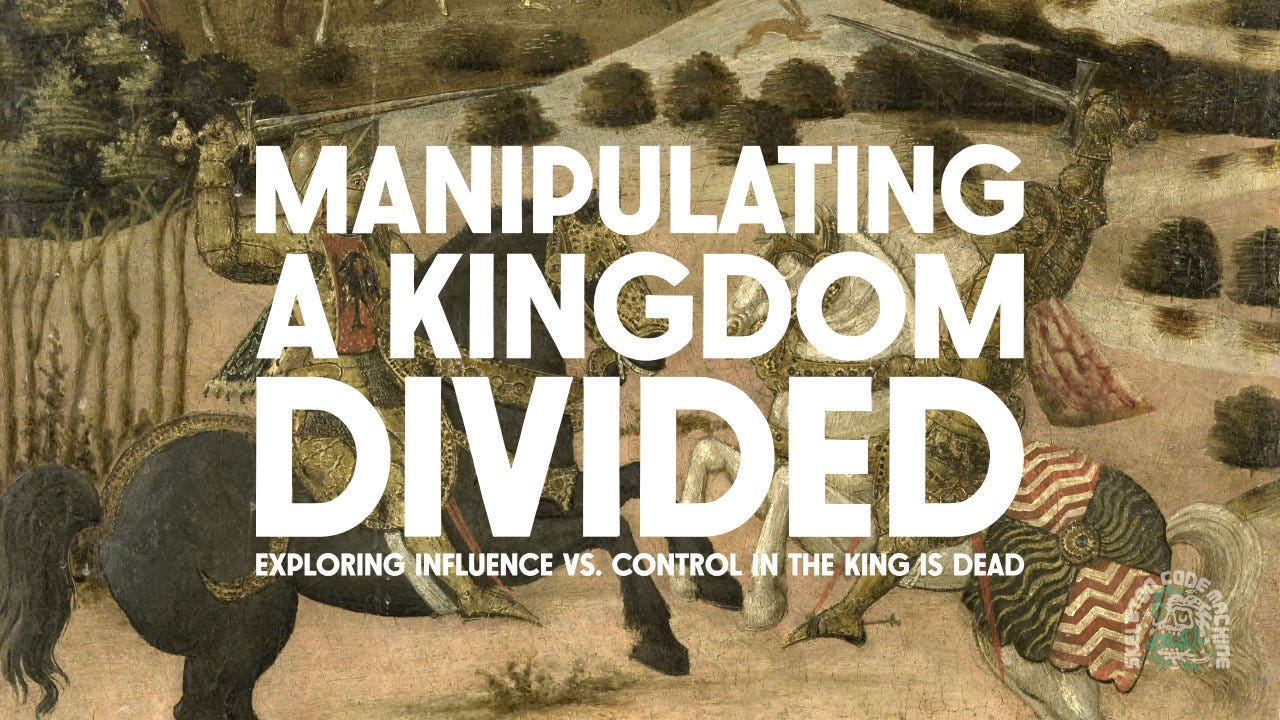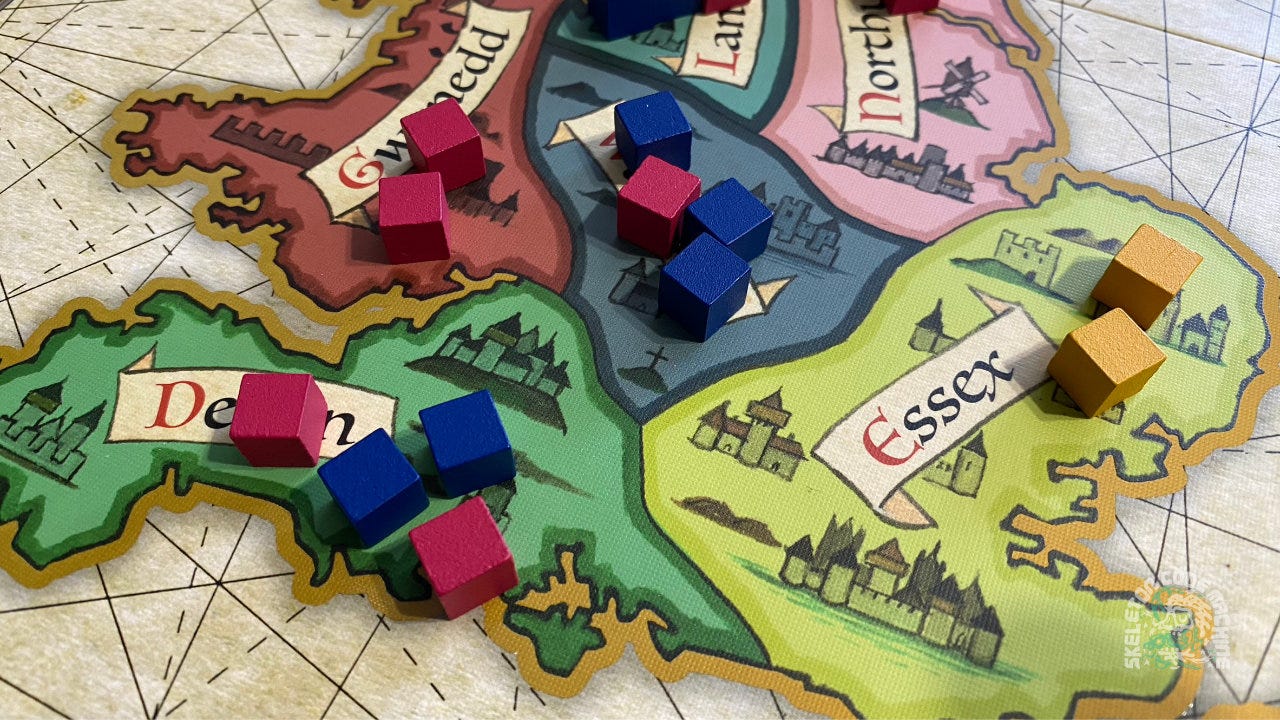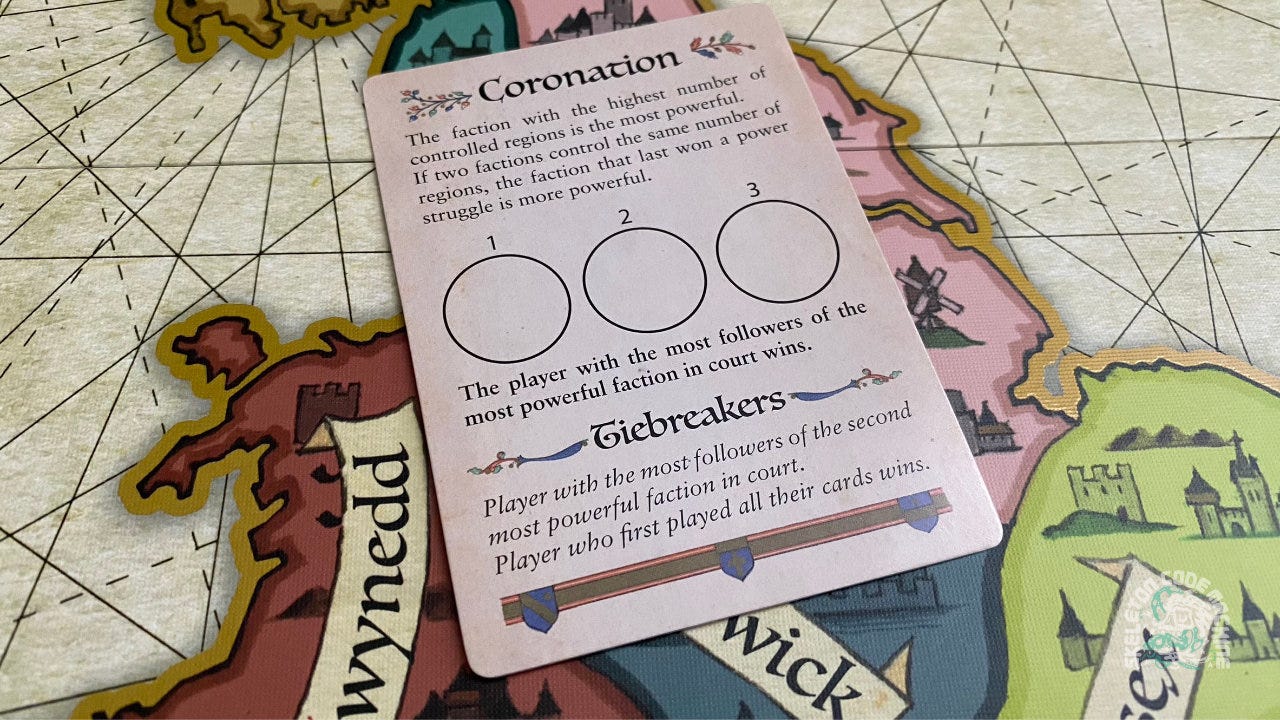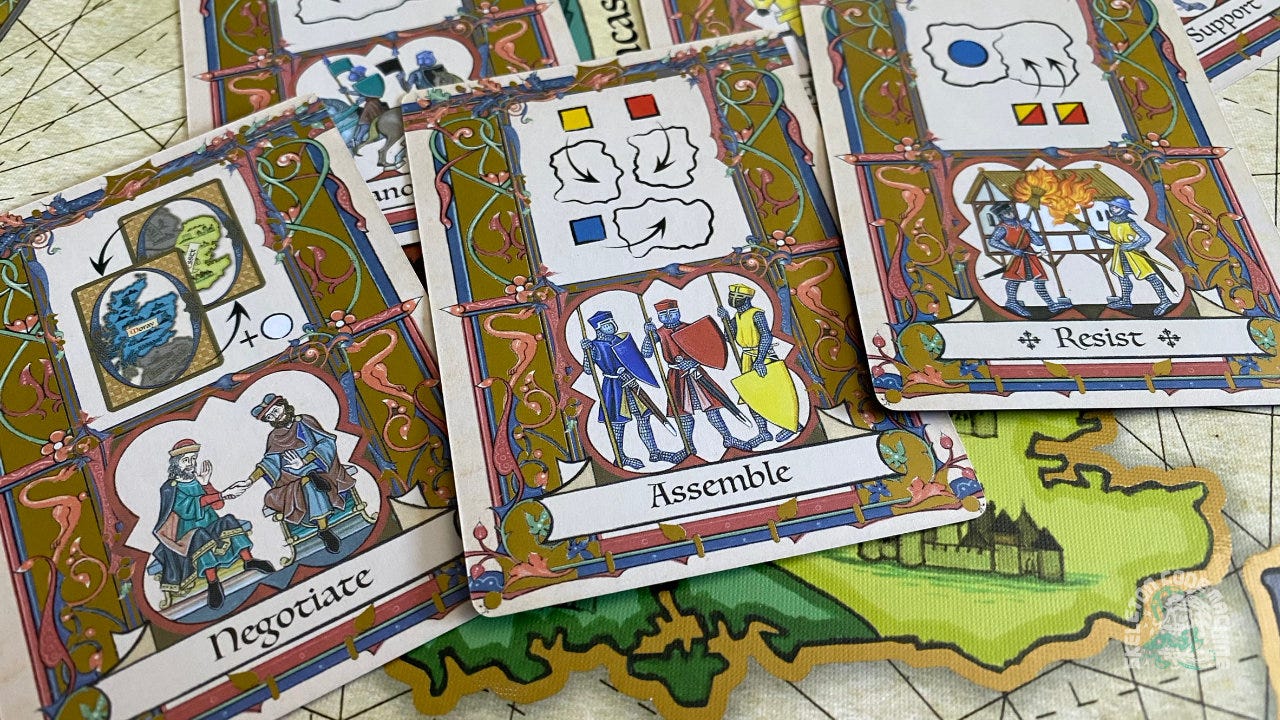Manipulating a kingdom divided
Exploring influence vs. control in The King is Dead
We’ve looked at area control before in both Zero Luck Combat and The Loki Strategy.
This week we look at area control (or more accurately “area majority”) in Peer Sylvester’s The King is Dead. The twist is there’s no combat, and you don’t actually control any of the factions!
The King is Dead
The King is Dead: Second Edition (2020) by Peer Sylvester is a “subtle game of shifting power” set in the Middle Ages:
The King is dead. The kingdom is divided. Three factions — the Scottish, the Welsh, and the English — vie for control and, across the sea, foreign invaders prepare to take advantage of the chaos. Players must marshal their limited resources to influence this power struggle, while ensuring that the faction that rises to dominate the realm favors them above all other claimants to the throne.
The game board is map of Britain divided into eight regions: Moray, Strathclyde, Northumbria, Lancaster, Warwick, Essex, Gwynedd, and Devon.
The faction followers are represented by wooden cubes: Scottish (blue), Welsh (red), and English (yellow). Each player also receives two random followers to place in front of them, forming their initial court.
Players take turns playing action cards, placing followers into regions, and summoning followers from regions into their courts.
The King is Dead is a great introduction to one of my favorite things in games: You don’t actually control one of the factions!
Invasion vs. Coronation
First, it’s important to understand the goal(s) of the game.
Up to eight regional power struggles will occur in an order decided by cards positioned around the board. The faction with the most follower cubes in the contested region takes control. A control disc is placed, all other follower cubes go back to the supply, and the region is effectively no longer part of the game.
If the power struggle results in a tie, however, the region is declared unstable and a black instability disc is placed. Place three of these instability discs and the game ends prematurely with a French invasion, changing the victory conditions.
So the goal of The King is Dead depends on how the end game is triggered:
French Invasion (3 instability discs): The winner is the player with the highest number of complete sets of followers (yellow, blue, red). Ties are won by the player who most recently played an action card.
Coronation (8 resolved power struggles: The factions are ranked by number of regions they control. The winner is the player with the most followers of the most powerful faction.
Do you want many followers of one faction, or distributed sets of all factions? The answer changes throughout the game!
Strengthen vs. Weaken
This shifting priority between invasion and coronation is complicated by this simple rule:
Whenever you take an action you will summon a follower to your court, increasing your influence with one of the factions. Each follower you take will solidify your claim to be that faction’s preferred ruler, but will weaken their ability to win power struggles.
You can play your Assemble card to place Scottish, Welsh, and English followers from the supply into any region or regions, but you’ll also have to take one follower off the map into your court.
This creates a complex puzzle of trying to line up the next power struggle region to fall the way you want, but also trying to not overly weaken other regions. Every action strengthens some regions while weakening another.
At the same time, you must manage who is summoned to your court to set yourself up to win when the end game is triggered!
The faction that you want to win changes throughout the game. Perhaps you started with a strong Scottish court, but now the English are clearly going to be the coronation faction. Suddenly you need to ditch your strategy and begin packing your court with English followers!
Influence vs. Control
Ultimately, The King is Dead is one of my favorite examples of a game where you don’t control a single faction. This is a unique and interesting mechanism as compared to most area control or area majority games.
Consider Blood Rage or Forbidden Stars as example of typical area control. You control and represent a single faction in the game, be it the Ram Clan or the Space Marines. You might have variable player powers, but you always want your team to win. Even if they are using the Loki strategy, the Ram Clan never wants the Bear Clan to control more provinces.
In The King is Dead, however, your faction allegiance changes and shifts throughout the game. You are influencing the factions, not controlling them. Adding some power here, and removing a little power there. Tweaking, tinkering, and carefully watching to predict which faction might end up being the strongest at the end of the game.
Owning a specific faction or color on the map is so ingrained into most players that this can be a very hard concept to internalize! A new player might ask, “So am I the English, Scottish, or Welsh?” The answer is that they are none of them and all of them at the same time!
This shift from control to influence creates a game conducive to themes of political scheming and control.
Other games of influence
While I think The King is Dead might be one of the best, condensed examples of influence vs. control, it certainly appears in other games as well.
My first exposure to the idea of not controlling a specific faction was Pax Renaissance: 2nd Edition by Phil Eklund and Matt Eklund. You represent one of four Renaissance bankers influencing factions across Europe via conspiracies, peasant revolts, religious wars, and trade. The rules (and exceptions to the rules) are an absolute beast, but it is a really interesting game.
If you want the fun and feel of Pax Renaissance but with more streamlined rules and a different theme, Pax Pamir: Second Edition by Cole Wehrle is another wonderful example:
In Pax Pamir, each player assumes the role of a nineteenth-century Afghan leader attempting to forge a new state after the collapse of the Durrani Empire. Western histories often call this period “The Great Game” because of the role played by the Europeans who attempted to use Central Asia as a theater for their own rivalries. In this game, those empires are viewed strictly from the perspective of the Afghans who sought to manipulate the interloping ferengi (foreigners) for their own purposes.
You maintain loyalty to one of the three factions (coalitions): British, Russian, and Afghan. That loyalty can, however, change multiple times per game. Your goal is to win the game, not to have a specific faction succeed.
It is my understanding that many of the GMT COIN games feature similar shifting factions, but I have (unfortunately) yet to play one of them. If you have, please leave a comment!
Conclusion
Some things to think about:
Consider alternatives to your players being a specific faction. It can be complicated and require a change in thinking, but can lead to really interesting and dynamic games. This is particularly tricky to accomplish in TTRPGs, but not impossible.
Variable victory conditions can create interesting player choices. Just like rewarding players for losing battles, making the selection of the final win conditions part of the game can lead to a unique experience.
You can have a deep game with simple components. It’s easy to slip into thinking that area control games need a grand, deluxe production with minis and piles of tokens. The King is Dead shows that you don’t necessarily need all of that, especially with the beautiful illustrations by Benoit Billion.
What are your favorite games that focus on influence versus control? Do you have any examples from the TTRPG world?
Skeleton Code Machine is a production of Exeunt Press. If you want to see what else is happening at Exeunt Press, check out the Exeunt Omnes newsletter.
See you next week!
— E.P. 💀









The whole 18xx genre of games revolves around playing as an investor and opening, closing, exchanging companies when seen fit.
Very cool! I don't think I've played a game that uses this mechanic but it sounds fascinating.